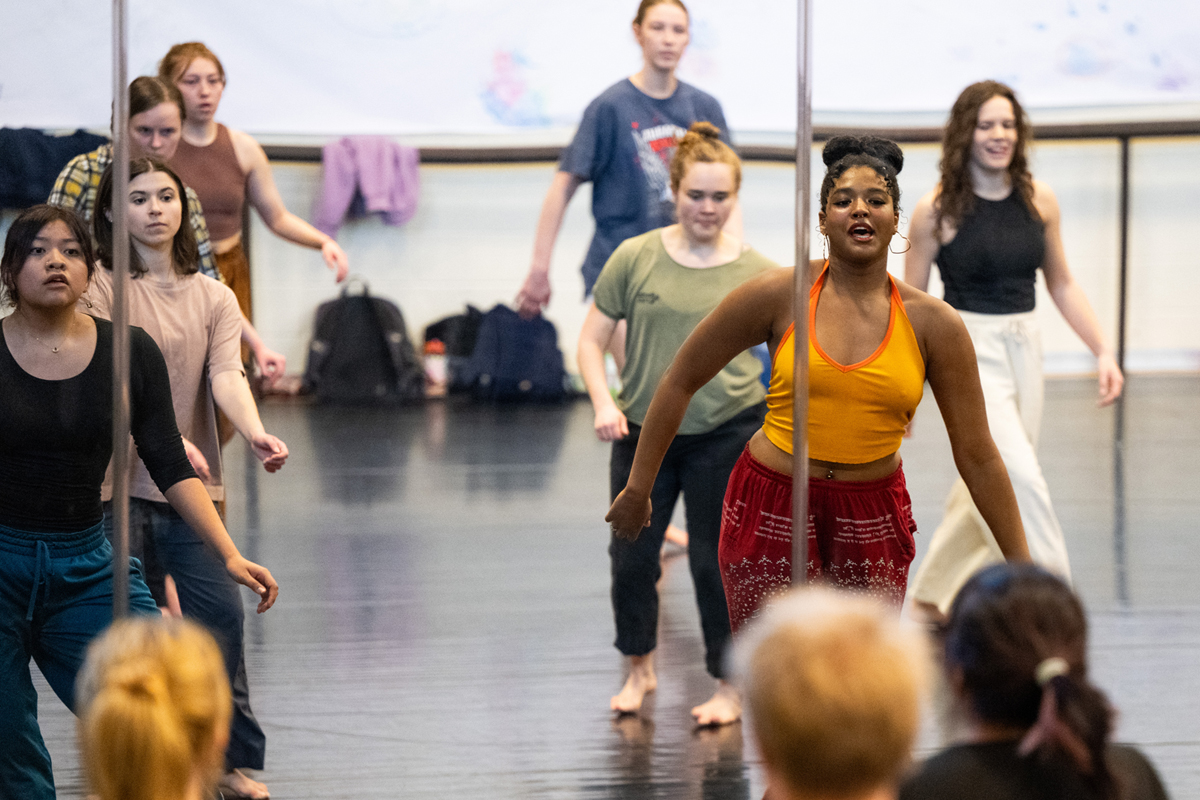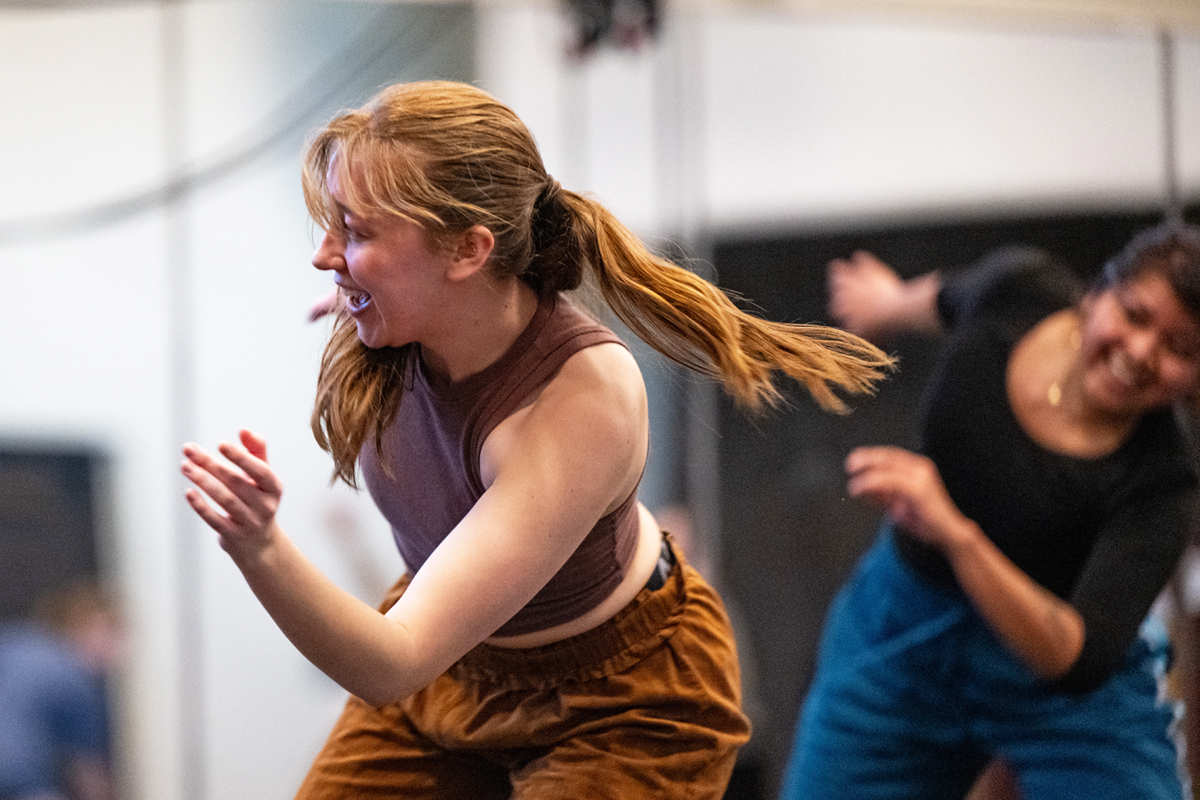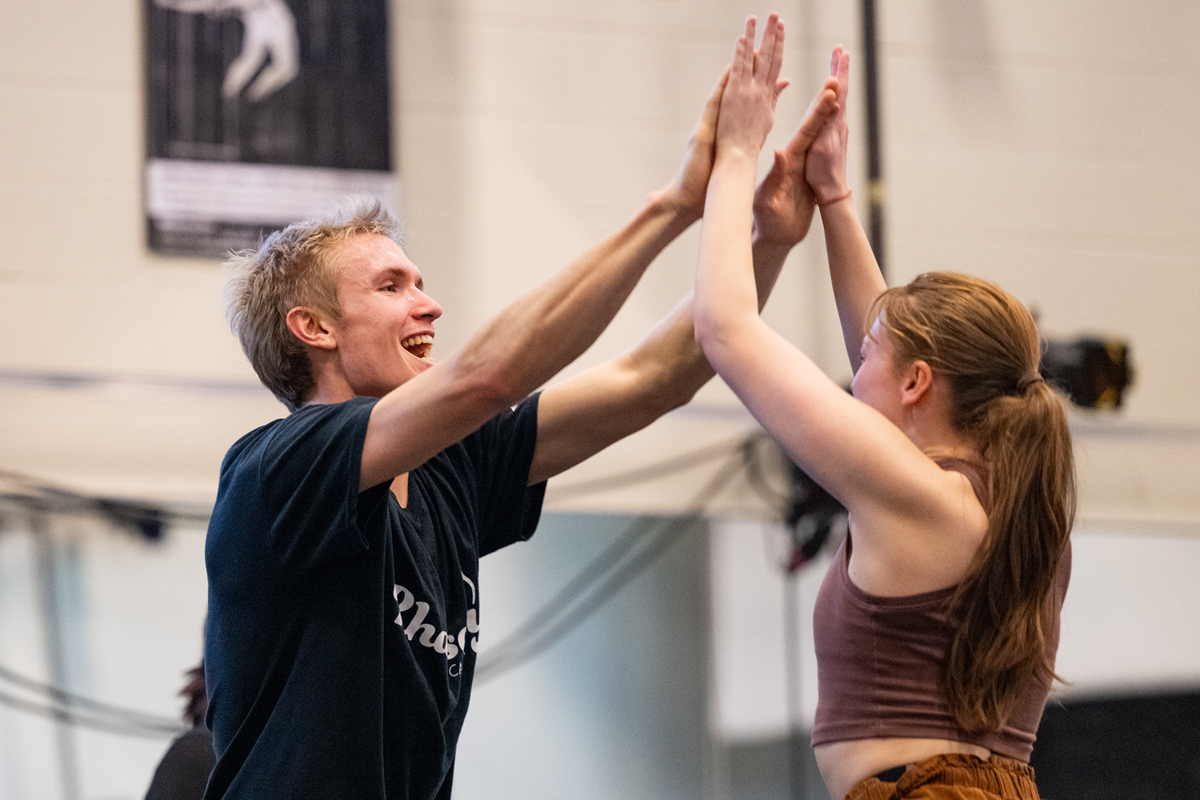Undergraduate Student Steps into Teacher Role, Brings Afro-Brazilian Dance to UM
By Abigail Lauten-Scrivner, UM News Service
MISSOULA – Every Friday afternoon at the University of Montana, exhilarated hoots, exhausted huffs and the smack of bare feet slapping the floor in unison echo to the beat of drums emanating from a large dance studio on the lower level of the Performing Arts and Radio/Television Center.
“You’re a warrior-hunter, you’re strong,” Julia Duarte called out one Friday to her class of 20-plus students as they stepped in sweeping, athletic turns across the floor, dancing in homage to Oxóssi, an Afro-Brazilian deity of hunting and prosperity. “Let yourself move. Don’t be scared of your own body.”
The 50-minute Afro-Brazilian dance class is composed of UM dance majors and minors, as well as students whose interest simply was piqued by the novel course, which has never been offered at the University before.

Another first is that Duarte, who leads her classroom with the poise and self-assurance of a practiced instructor, is only a senior undergraduate dance student taking on a semester-long teaching project.
“It’s the greatest privilege ever as a teacher-mentor to get to sit back, to be so confident and in awe of someone who has been your student,” said Professor and Head of Dance Heidi Jones Eggert, who serves as Duarte’s faculty mentor and the instructor of record for the class. “I think the students in her class can learn so much by seeing her accept this challenge.”
But when Duarte was growing up in São Paulo, Brazil, going to college at all – let alone in Montana – wasn’t a part of her plan. Dance, however, always was.
“Dance is like oxygen for me,” Duarte said. “It's something that I just kind of need.”
Duarte began ballet at age 3 when her mom noticed her wiggling to the dissonant tune of the electric blender. “She was like, ‘This kid needs to be moving,’” Duarte said through laughs. “I will dance to anything.”
Duarte’s talent quickly became obvious. At age 11 she joined a ballet company where everyone else was at least 15 years old. During a competition in Italy, Duarte connected with Charlene Campbell Carey, artistic director of Rocky Mountain Ballet Theatre, who offered Duarte a full-ride scholarship to attend Missoula-based Ballet Beyond Borders.
As Duarte continued to visit Missoula for trainings and competitions, Campbell Cary saw how smart she was and encouraged her to pursue a bachelor’s degree at UM – something Duarte previously hadn’t seriously considered.
Without Campbell Cary’s support, Duarte said she might have stopped dancing. She did once quit for four months after burning out and becoming discouraged by being so much younger than the rest of her company. But quitting didn’t work for her. When Duarte returned, dance changed from the only thing she knew to something she actively chose. Her relationship with dance continued to improve as she learned to parse the world of dance from the art.
“The world of dance can ruin the art for me, so I have to keep my eyes on what dance really is in essence,” Duarte said, noting the expectations to have a perfect body, the right color skin or the ideal height.
“I think a lot of what made me hate dance for a while was that I couldn’t fit in those little boxes,” she said. “That doesn't mean I have to quit dancing.”
As valuable as Duarte’s professional training was to developing her talent, equally so were the informal lessons she naturally was steeped in growing up in Afro-Brazilian culture.
“I had a lot of dance outside ballet, but I didn’t know it at the time. It was just part of life,” Duarte said, recalling learning samba from her aunt and capoeira dance fighting from her uncle. Capoeira, a martial arts-dance hybrid, originated from African slaves in Brazil devising a way to practice defending themselves without their enslavers’ knowledge.
Afro-Brazilian dance encompasses numerous styles, many of which connect to the religions enslaved Africans brought to Brazil and blended with the Catholic beliefs of their enslavers. Some Afro-Brazilian dances pay homage to deities called orixás.

Duarte’s background in Afro-Brazilian, ballet and contemporary dance informed her own unique style as she further honed her craft at UM. “In the time that I’ve spent here, I observed how differently I move from everybody else,” Duarte said.
For her junior project, Duarte explored how Afro-Brazilian movements look on dancers trained in the U.S. She found they tended to carry unnecessary tension, causing their bodies to look rigid and tire quickly. But after a few sessions, they loosened up and improved.
Dance Assistant Professor Brooklyn Draper and Jones Eggert observed how Duarte’s lessons both excited students and improved their technique.
“Julia does such a good job of creating this space where students feel safe to move in ways that they’re not used to,” Draper said. “To be able to learn it from a peer that they respect and admire, it’s great for them.”
The faculty members asked Duarte about expanding the lessons into a semester-long, for-credit class. She was ecstatic about the opportunity.
“I love that I get to spread a little bit of my culture in Missoula, Montana, of all places,” Duarte said. “I’m so honored. When I talked to my family, my mom was crying and so proud.”
Duarte was cognizant of the responsibility to do right by her culture while teaching Afro-Brazilian dance to a classroom largely unfamiliar with its history. She structures each class around an Afro-Brazilian deity and begins with a lesson about its cultural context, characteristics and symbolism. Learning about the orixás helps students understand what energy to bring to the floor and better embody its movement.
“I can’t just teach the movement without the history behind it,” Duarte said. “I think my ancestors would kill me if I did that, so I just want to make sure I do it right.”
Anna Cline, a senior resource conservation major minoring in dance and wilderness studies, has danced since seventh grade but never took an Afro-Brazilian course until now. She’s found it challenging and exhilarating, and enjoys learning about a different culture while also expanding her technique.
“Julia is very encouraging,” Cline said. “I think a lot of us leave feeling empowered, and also exhausted.”

Leading a class of 20-plus students with varying dance expertise and different styles of learning has been a joyful challenge that’s solidified Duarte’s desire to continue teaching. While she will graduate soon, Duarte plans to teach the class again next academic year. Later, she hopes to attend UM’s budding occupational therapy program, coming fall 2025.
Although Duarte stepping up as an undergraduate to lead a semester-long teaching project is a first as far as Draper and Jones Eggert know, they noted that the School of Theatre and Dance has facilitated many other students in pursuing their own unique ambitions.
“That's our goal for every student here. We want to support them in finding their artistic voice,” Jones Eggert said. “That can go any direction, and it’s our job to help them figure it out.”
###
Video: A video of Duarte’s Afro-Brazilian dance class is online. (UM Video by Austin Valley)
Contact: Heidi Jones Eggert, UM professor and head of dance, 406-243-2072, heidi.eggert@umontana.edu.